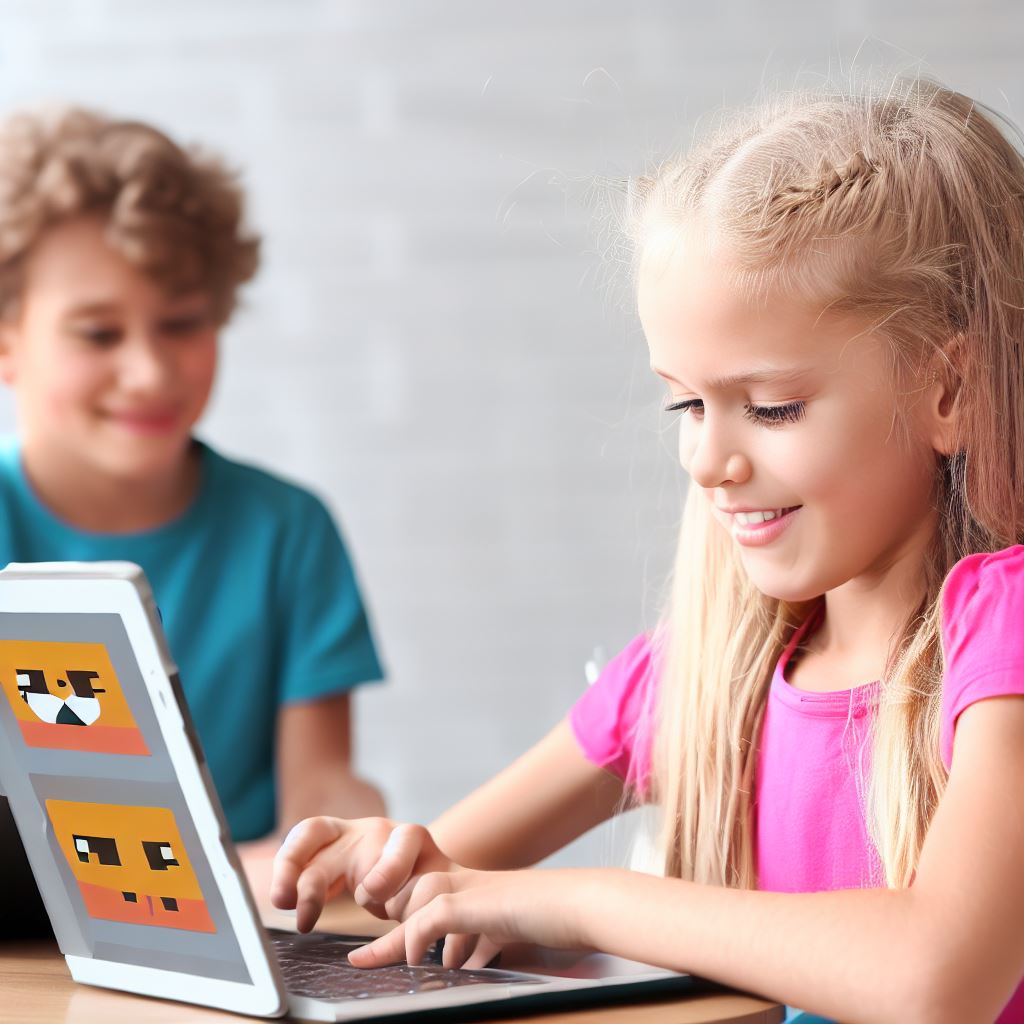The Benefits of Scratch Coding for Children’s Cognitive Skills
Last Updated on September 19, 2023
Introduction
The Benefits of Scratch Coding for Cognitive Skills extend beyond programming proficiency, promoting problem-solving abilities and creative thinking in young learners.
Coding is the process of giving instructions to a computer or a device to perform certain tasks. Scratch coding is a visual programming language developed by the MIT Media Lab.
It allows users to create interactive stories, games, and animations by dragging and dropping blocks of code.
The topic of this chapter focuses on the benefits of Scratch coding for children’s cognitive skills. Cognitive skills refer to a person’s mental abilities, including memory, attention, problem-solving, and logical thinking.
By engaging in Scratch coding, children can enhance these skills in various ways.
Another advantage of Scratch coding is that it promotes collaboration and communication skills. Children can share their projects with others, receive feedback, and even collaborate on coding projects together.
This collaborative aspect not only improves their technical skills but also enhances their teamwork and communication abilities.
Additionally, Scratch coding improves children’s math and computational skills. They learn about concepts such as sequencing, loops, and conditionals.
Therefore, Scratch coding offers numerous benefits for children’s cognitive skills. It nurtures creativity, critical thinking, collaboration, and computational skills.
By engaging in Scratch coding, children can develop a strong foundation for future learning and success in a digital world.
Definition and explanation of cognitive skills
Cognitive skills can be defined as the mental processes and abilities that help individuals think, understand, learn, remember, and problem-solve.
These skills play a crucial role in a person’s overall cognitive development and academic success.
Introduction to cognitive skills
Cognitive skills encompass a wide range of mental abilities that enable individuals to process information, make decisions, and interact with their environment.
They involve various cognitive processes such as perception, attention, memory, language, and reasoning.
Children begin developing cognitive skills from a very young age, and these skills continue to develop and refine throughout their lives.
Cognitive development is especially rapid during early childhood, and it lays the foundation for future learning and academic achievements.
Importance of cognitive skills in children’s development
Cognitive skills are crucial for children’s overall development as they form the building blocks for various academic and life skills.
These skills enable children to understand concepts, problem-solve, communicate effectively, and perform well in school.
One of the key benefits of developing strong cognitive skills is improved academic performance.
Children with well-developed cognitive skills are better able to focus, comprehend complex concepts, and apply critical thinking skills in their studies.
Furthermore, cognitive skills also play a significant role in shaping children’s social and emotional development.
They help children understand and regulate their emotions, communicate effectively with others, and form meaningful relationships.
Examples of cognitive skills
- Perception: This cognitive skill involves the ability to interpret and make sense of sensory information from the environment, such as recognizing shapes, colors, and patterns.
- Attention: Attention is the ability to concentrate on specific stimuli while filtering out distractions. It is crucial for learning, problem-solving, and completing tasks successfully.
- Memory: Memory is the ability to encode, store, and retrieve information. It allows children to remember important facts, concepts, and experiences, which is fundamental for acquiring new knowledge.
- Language: Language skills involve the ability to understand and use language to communicate effectively. It includes vocabulary development, grammar, comprehension, and verbal expression.
- Reasoning: Reasoning is the cognitive skill that enables children to think logically, analyze information, make connections, and draw conclusions. It is essential for problem-solving and critical thinking.
- Executive functions: Executive functions refer to a set of cognitive skills that control and regulate other cognitive processes. These include skills such as planning, organizing, self-control, and decision-making.
- Creativity: Although often associated with artistic endeavors, creativity is also a cognitive skill that involves thinking outside the box, generating ideas, and finding innovative solutions to problems.
- Spatial awareness: Spatial awareness is the ability to understand and mentally manipulate objects in the environment. It is crucial for tasks such as reading maps, solving puzzles, and understanding geometry.
In essence, cognitive skills are fundamental for children’s cognitive development and academic success.
They encompass various mental processes and abilities that enable children to think, understand, learn, remember, and problem-solve.
Nurturing and developing these skills through activities like Scratch coding can have numerous benefits for children’s cognitive development and overall well-being.
Overview of Scratch coding
Scratch coding is a visual programming language designed to introduce children to coding concepts.
It allows children to create interactive stories, games, and animations by dragging and dropping code blocks.
Scratch coding works by assembling blocks of code that fit together like puzzle pieces.
Children can control characters, make them move, respond to user input, and create their own unique projects.
Examples of projects that can be built using Scratch
- Interactive stories: Children can create their own stories with multiple characters and branching narratives.
- Games: Scratch allows children to design and develop games with objectives, levels, and challenges.
- Animations: Children can make characters come to life with motion, effects, and sound.
- Simulations: Scratch can be used to simulate real-life scenarios like weather patterns or ecosystems.
- Educational tools: Teachers can use Scratch to create interactive lessons and quizzes for their students.
Read: Admission Tips: Navigating Coding Dojo’s Interview Process
Benefits of Scratch coding for children’s cognitive skills
Develops problem-solving skills
- Scratch coding encourages logical thinking, which helps children solve problems effectively.
- It strengthens critical thinking abilities, teaching children how to analyze and evaluate different situations.
Enhances creativity and imagination
- Scratch coding allows children to express themselves through code, fostering their creativity.
- It sparks innovation and originality as they learn to apply their imagination to create unique projects.
Improves computational thinking
- Teaching children to break down complex problems into smaller parts develops their computational thinking skills.
- Scratch coding enhances algorithmic thinking and planning, enabling children to create efficient solutions.
Promotes perseverance and resilience
- Scratch coding encourages children to debug and fix errors, teaching perseverance and problem-solving skills.
- It builds resilience in the face of challenges, as children learn to overcome obstacles through trial and error.
Fosters collaboration and communication skills
- Scratch coding enables children to work together on coding projects, fostering collaboration.
- It enhances communication and teamwork abilities as they learn to collaborate and share ideas.
Read: Job Placement Rates: Analyzing Coding Dojo’s Success

Real-life examples and success stories
Case studies of children benefiting from Scratch coding
- John, a 10-year-old, improved his problem-solving skills through Scratch coding.
- Sarah, an 8-year-old, enhanced her creativity and imagination by creating interactive stories in Scratch.
- Michael, a 12-year-old, developed logical thinking abilities through debugging and troubleshooting his Scratch projects.
Success stories of children who started with Scratch and excelled in coding
- Emily, a 13-year-old, started with Scratch and later won a regional coding competition with her advanced projects.
- Josh, a 9-year-old, began his coding journey with Scratch and now creates his own websites using more complex programming languages.
- Natalie, an 11-year-old, started with Scratch and eventually developed her own mobile game app, gaining recognition in the tech industry.
These real-life examples and success stories highlight the positive impact Scratch coding has on children’s cognitive skills. Through case studies and success stories, we can see the following benefits:
- Improved problem-solving skills: Children like John, who engage in Scratch coding, learn to analyze problems and find creative solutions.
- Enhanced creativity and imagination: Sarah’s experience shows how Scratch allows children to explore their creativity and unleash their imagination.
- Developed logical thinking abilities: Michael’s progress demonstrates how Scratch coding helps children think logically and analytically.
- Advanced coding skills: Emily, Josh, and Natalie’s success stories prove that starting with Scratch can pave the way for excelling in more complex programming languages.
These examples also highlight the long-term benefits of Scratch coding beyond just cognitive skills:
- Building confidence and self-esteem: As children achieve success in coding, they develop a sense of accomplishment and pride in their abilities.
- Encouraging collaborative learning: Scratch fosters collaboration among children through shared projects and sharing of ideas.
- Preparing for future careers: With coding becoming increasingly important in various industries, starting early with Scratch equips children with valuable skills for future job opportunities.
As more children embrace Scratch coding, we can expect to witness even more impressive achievements and success stories in the coding world.
It is clear that Scratch is not only a valuable educational tool but also a stepping stone towards a bright future in technology and innovation.
Read: How Coding Powers the USA’s Top Companies: A Deep Dive
Tips for parents and educators
How to introduce Scratch coding to children
- Start by explaining the concept of coding and its relevance in today’s digital world.
- Show children examples of projects created using Scratch to get them excited about its possibilities.
- Begin with simple step-by-step tutorials to help children understand the basic building blocks of Scratch.
- Encourage children to experiment and explore different features of Scratch to foster creativity.
- Provide opportunities for children to collaborate and share their projects with others.
Resources and tools for learning Scratch
- Use online platforms such as Scratch.mit.edu, which offers a wealth of tutorials, demo projects, and a supportive community.
- Utilize coding games and apps like ScratchJr, Scratch, Blockly, or Scratch 3.0 offline editor.
- Consider purchasing coding books or attending coding workshops specifically designed for children learning Scratch.
- Explore coding clubs or after-school programs that focus on teaching Scratch to children.
- Engage with online forums and social media groups to connect with other parents and educators for additional resources.
Encouraging and supporting children in their coding journey
- Praise and acknowledge children’s efforts and progress in Scratch coding to boost their confidence.
- Provide a safe and positive learning environment where children feel comfortable exploring and making mistakes.
- Set realistic goals and milestones to help children track their progress and stay motivated.
- Offer guidance and support when children encounter challenges or get stuck on a coding problem.
- Encourage children to share their projects with friends, family, and peers to receive constructive feedback.
Introducing children to coding through Scratch can have numerous benefits for their cognitive skills. To ensure an effective introduction, parents and educators need to follow certain guidelines.
First, it is crucial to explain the concept of coding and its relevance in today’s digital world. By demonstrating real-life examples of projects created using Scratch, children can get excited about its possibilities.
To facilitate learning, parents and educators can utilize various resources and tools. Online platforms like Scratch.mit.edu offer a rich collection of tutorials, demo projects, and a supportive community.
Moreover, coding games and apps such as ScratchJr, Scratch Blockly, or Scratch 3.0 offline editor provide interactive learning experiences.
This allows for an exchange of ideas, resources, and best practices in teaching Scratch to children.
By following the tips provided, parents and educators can ensure a successful introduction of Scratch coding, provide the necessary resources, and offer support throughout children’s coding journey.
By fostering their creativity, problem-solving abilities, and collaboration skills, children can thrive in the world of coding with Scratch.
Conclusion
Scratch coding undeniably offers numerous cognitive benefits for children, making it a valuable educational tool.
Therefore, it is essential to encourage parents and educators to explore and embrace the world of Scratch coding as a means to nurture young minds and equip them with vital skills for the future.
Lastly, the advantages of Scratch coding for children’s cognitive skills are evident and compelling.
It is imperative for parents and educators to actively delve into the realm of Scratch coding, recognizing its potential to enhance children’s learning experiences and prepare them for the challenges of tomorrow’s digital world.
When introducing Scratch coding to children, it is recommended to start with simple step-by-step tutorials.
This approach helps children understand the basic building blocks of Scratch and gradually develop their skills.
Additionally, providing opportunities for children to experiment and explore different features of Scratch fosters their creativity and problem-solving abilities.


